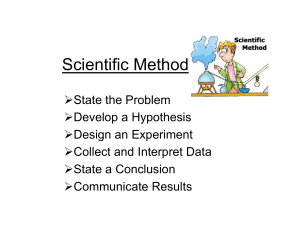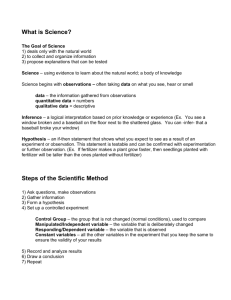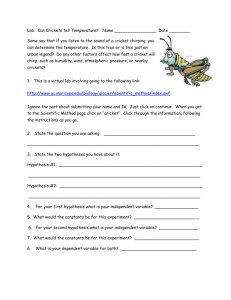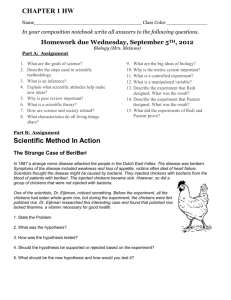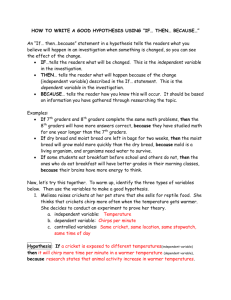Steps of the Scientific Method
advertisement
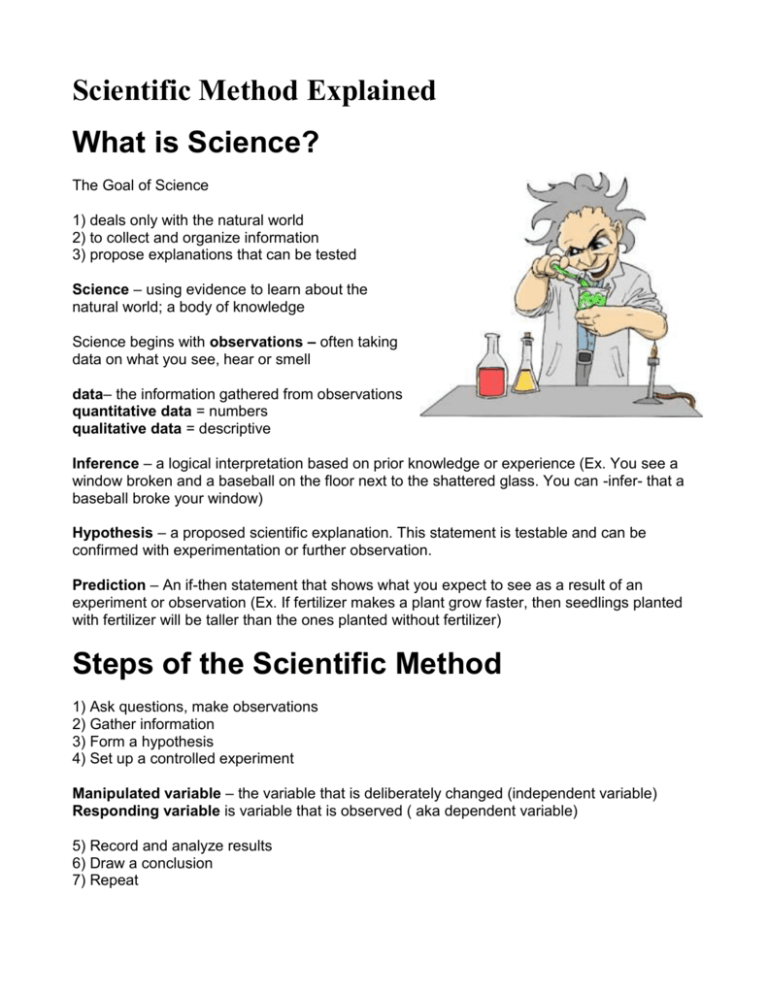
Scientific Method Explained What is Science? The Goal of Science 1) deals only with the natural world 2) to collect and organize information 3) propose explanations that can be tested Science – using evidence to learn about the natural world; a body of knowledge Science begins with observations – often taking data on what you see, hear or smell data– the information gathered from observations quantitative data = numbers qualitative data = descriptive Inference – a logical interpretation based on prior knowledge or experience (Ex. You see a window broken and a baseball on the floor next to the shattered glass. You can -infer- that a baseball broke your window) Hypothesis – a proposed scientific explanation. This statement is testable and can be confirmed with experimentation or further observation. Prediction – An if-then statement that shows what you expect to see as a result of an experiment or observation (Ex. If fertilizer makes a plant grow faster, then seedlings planted with fertilizer will be taller than the ones planted without fertilizer) Steps of the Scientific Method 1) Ask questions, make observations 2) Gather information 3) Form a hypothesis 4) Set up a controlled experiment Manipulated variable – the variable that is deliberately changed (independent variable) Responding variable is variable that is observed ( aka dependent variable) 5) Record and analyze results 6) Draw a conclusion 7) Repeat The Scientific Method in Action Suppose you observed that a cricket outside your window seems to be chirping every night, but some nights it chirps faster than others. A friend of yours told you once that you can use the sound of a cricket chirp to tell the temperature. Curious, you decide to design an experiment. First you must create a hypothesis; here are some examples of possible hypotheses: The frequency of cricket chirps will change as the temperature changes. As the temperature decreases, a cricket will chirp fewer times. Either hypothesis will work, the important thing is that you can -test- the hypothesis by doing an experiment which will confirm or deny the statement. To set up the experiment, you go out to your yard and capture a few crickets. You bring them inside and place them in a container. But wait, if you have a bunch of crickets together, what if they chirp based on how many crickets there are nearby. The goal in designing an experiment is to eliminate all the variables except the one you are testing. This means all your cricket subject must be housed in the same environment (same lighting, same food, same water..etc). Okay, so you get that set up and take the temperature of your room. Now you must wait for the crickets to start chirping. You count how many times the cricket chirps for a 5 minute period. Now you have to compare that number with the chirps that occur at different temperatures. You may use a heating pad, or ice or any other way to lower or raise their temperature. You would then take data for 5 minutes at the new temperature. In your experiment, the MANIPULATED VARIABLE is the thing you changed – the temperature. The RESPONDING VARIABLE is what you are measuring that happens as a result of that change the number of chirps. The CONTROL GROUP isn’t obvious in this case – but you can consider your original (room temperature) data as your control, and the other temperatures your experimental data. After you have taken data, you can then draw a conclusion about whether your hypothesis is accepted (correct) or denied (incorrect). Scientific Method In Action The Strange Case of BeriBeri In 1887 a strange nerve disease attacked the people in the Dutch East Indies. The disease was beriberi. Symptoms of the disease included weakness and loss of appetite, victims often died of heart failure. Scientists thought the disease might be caused by bacteria. They injected chickens with bacteria from the blood of patients with beriberi. The injected chickens became sick. However, so did a group of chickens that were not injected with bacteria. One of the scientists, Dr. Eijkman, noticed something. Before the experiment, all the chickens had eaten whole-grain rice, but during the experiment, the chickens were fed polished rice. Dr. Eijkman researched this interesting case and found that polished rice lacked thiamine, a vitamin necessary for good health. 1. State the Problem 2. What was the hypothesis? 3. How was the hypothesis tested? 4. Should the hypothesis be supported or rejected based on the experiment? 5. What should be the new hypothesis and how would you test it? How Penicillin Was Discovered In 1928, Sir Alexander Fleming was studying Staphylococcus bacteria growing in culture dishes. He noticed that a mold called Penicillium was also growing in some of the dishes. A clear area existed around the mold because all the bacteria that had grown in this area had died. In the culture dishes without the mold, no clear areas were present. Fleming hypothesized that the mold must be producing a chemical that killed the bacteria. He decided to isolate this substance and test it to see if it would kill bacteria. Fleming transferred the mold to a nutrient broth solution. This solution contained all the materials the mold needed to grow. After the mold grew, he removed it from the nutrient broth. Fleming then added the nutrient broth in which the mold had grown to a culture of bacteria. He observed that the bacteria died which was later used to develop antibiotics used to treat a variety of diseases. 6. Identify the problem. 7. What was Fleming's hypothesis? 8. How was the hypothesis tested? 9. Should the hypothesis be supported or rejected based on the experiment? 10. This experiment lead to the development of what major medical advancement? The Elephant Poem by John Godfrey Saxe (1816-1887) It was six men of Indostan To learning much inclined Who went to see the Elephant (Though all of them were blind), That each by observation Might satisfy his mind The First approached the Elephant, And happening to fall Against his broad and sturdy side, At once began to bawl: "God bless me! but the Elephant Is very like a wall!" The Second, feeling of the tusk, Cried, "Ho! what have we here So very round and smooth and sharp? To me 'tis mighty clear This wonder of an Elephant Is very like a spear!" The Third apprached the animal, And happening to take The squirming trunk within his hands, Thus boldly up and spake: "I see," quoth he, "the Elephant Is very like a snake." The Fourth reached out an eager hand, And felt about the knee. "What most this wondrous beast is like Is mighty plain," quoth he; "Tis Clear enough the Elephant Is very like a tree." The Fifth, who chanced to touch the ear, Said: "E'en the blindest man Can tell what this resembles most; Deny the fact who can, This marvel of an Elephant Is very like a fan!" The Sixth no sooner had begun About the beast to grope, Then seizing on the swinging tail That fell within his scope, "I see," quoth he, "the Elephant Is very like a rope." And so these men of Indostan Disputed loud and long. Each in his own opinion Exceeding stiff and strong, Though each was partly in the right, And all were in the wrong Literature and the Scientific Method 1. How does this poem illustrate the importance of observation in the scientific method? 2. What is the moral of the tale? 3. Many scientific errors can occur because the researcher does not use good skills of observation. Imagine a scenario where not being observant can result in an experiment going wrong. Describe this scenario in the form of a story or a poem. Independent and Dependent (Responding) Variables Scenario 1. One cow is fed a growth hormone and another cow is not. After a year, both cows are weighed. 2. Mosquito repellent is sprayed on one arm and the other arm is not sprayed. The number of mosquito bites is counted after 2 hours. 3. Bob studies for a test and Jackie does not study. After the test, they compare their scores. 4. Two cars are on a track and accelerate to 60 mph. At a certain point, both cars slam on the brakes. The distance it takes for each car to stop is then measured. 5. A group of people take a diet pill. After 3 months, they measure the amount of weight they lost. 6. Ants are placed in a tray that is shaped like a T, at the end of the T, the ants can either go to a darkened area or a light area. Students count how many ants end up on the dark side and how many end up on the light side. 7. One company states that it makes the best staplers. To prove it, they use the stapler to staple a thousand papers and compare it to a competitor. The competitor’s stapler jammed 3 x whereas their stapler only jammed once. 8. A pediatrician designs baby formula to help babies gain weight. To show his formula works, he compares the weights of babies that have been using the formula to the weights of babies not on the formula. Independent variable Responding variable Scenario Independent variable Responding variable 9. Cockroaches are exposed to the chemical dioxin. After 3 hours, 45/100 cockroaches are dead. 10. New houses are spayed on the outside with an insulating paint. After a year, researchers determine how much energy each house used. Scientific Method - Group Project Instructions: Give each group or pair one of the scenarios below. Ask the group to design and experiment to answer the experimental question. Students should identify a control group, dependent and independent variables and possible outcomes or what type of data would be gathered. Stress to students that they will not actually be performing these experiments. Have students either turn in their design on paper or do a mini-presentation to the class. Does the wavelength of light (R.O.Y.G.B.I.V.) affect a plant’s growth? Does Rogaine really improve hair growth? Is acid rain causing a decline of frog populations? Does the hormone estrogen increase the milk yield of dairy cows? Does the size of a fish tank determine how large a fish will grow? Does aspirin keep cut roses fresher longer? Will crickets chirp more if the temperature is warmer? Do wounds heal faster when they are covered by Band-Aids? Which battery lasts longer, energizer or duracell? Does hot water freeze faster than cold water? Do tanning beds cause skin cancer? What causes leaves to fall in autumn (light, temperature, or both)? * Images obtained from clker.com Identify the Controls and Variables Smithers thinks that a special juice will increase the productivity of workers. He creates two groups of 50 workers each and assigns each group the same task (in this case, they're supposed to staple a set of papers). Group A is given the special juice to drink while they work. Group B is not given the special juice. After an hour, Smithers counts how many stacks of papers each group has made. Group A made 1,587 stacks, Group B made 2,113 stacks. Identify the: Homer notices that his shower is covered in a strange green slime. His friend Barney tells him that coconut juice will get rid of the green slime. Homer decides to check this this out by spraying half of the shower with coconut juice. He sprays the other half of the shower with water. After 3 days of "treatment" there is no change in the appearance of the green slime on either side of the shower. 6. What was the initial observation? Bart believes that mice exposed to radiowaves will become extra strong (maybe he's been reading too much Radioactive Man). He decides to perform this experiment by placing 10 mice near a radio for 5 hours. He compared these 10 mice to another 10 mice that had not been exposed. His test consisted of a heavy block of wood that blocked the mouse food. he found that 8 out of 10 of the radiowaved mice were able to push the block away. 7 out of 10 of the other mice were able to do the same. Identify the- Krusty was told that a certain itching powder was the newest best thing on the market, it even claims to cause 50% longer lasting itches. Interested in this product, he buys the itching powder and compares it to his usual product. One test subject (A) is sprinkled with the original itching powder, and another test subject (B) was sprinkled with the Experimental itching powder. Subject A reported having itches for 30 minutes. Subject B reported to have itches for 45 minutes. Identify the- 1. Control Group 2. Independent Variable 3. Dependent Variable 4. What should Smithers' conclusion be? 5. How could this experiment be improved? Identify the7. Control Group 8. Independent Variable 9. Dependent Variable 10. What should Homer's conclusion be? It doesn't work 11. Control Group 12. Independent Variable 13. Dependent Variable 14. What should Bart's conclusion be? 15. How could Bart's experiment be improved? 16. Control Group 17. Independent Variable 18. Dependent Variable 19. Explain whether the data supports the advertisements claims about its product. - It does Lisa is working on a science project. Her task is to answer the question: "Does Rogooti (which is a commercial hair product) affect the speed of hair growth". Her family is willing to volunteer for the experiment. 20. Describe how Lisa would perform this experiment. Identify the control group, and the independent and dependent variables in your description.
